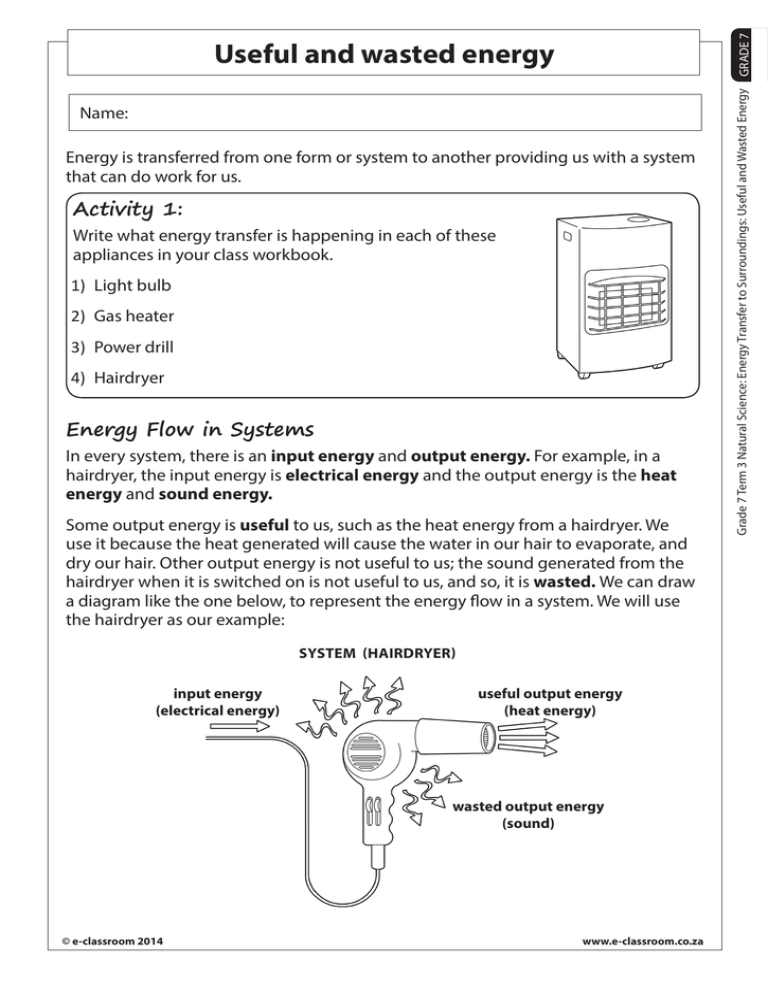Useful and wasted energy - E
advertisement

GRADE 7 Name: Energy is transferred from one form or system to another providing us with a system that can do work for us. Activity 1: Write what energy transfer is happening in each of these appliances in your class workbook. 1) Light bulb 2) Gas heater 3) Power drill 4) Hairdryer Energy Flow in Systems In every system, there is an input energy and output energy. For example, in a hairdryer, the input energy is electrical energy and the output energy is the heat energy and sound energy. Some output energy is useful to us, such as the heat energy from a hairdryer. We use it because the heat generated will cause the water in our hair to evaporate, and dry our hair. Other output energy is not useful to us; the sound generated from the hairdryer when it is switched on is not useful to us, and so, it is wasted. We can draw a diagram like the one below, to represent the energy flow in a system. We will use the hairdryer as our example: SYSTEM (HAIRDRYER) input energy (electrical energy) useful output energy (heat energy) wasted output energy (sound) © e-classroom 2014 www.e-classroom.co.za Grade 7 Term 3 Natural Science: Energy Transfer to Surroundings: Useful and Wasted Energy Useful and wasted energy Energy Efficient Systems Have you heard of “energy saving light bulbs”? You may have heard that they are more energy efficient than normal incandescent light bulbs. This means that more of the input energy is transferred into useful output energy, and less output energy is wasted. Think about this: In an incandescent light bulb, 100J of electrical energy is needed every second to make it work. Of this, 5J of light energy is produced per second. 95J of heat energy is also produced per second. We use a light bulb for LIGHT; so, only 5J of the 100J of input energy is useful output energy (light) and 95J is wasted (heat). In energy saving light bulbs (or compact fluorescent light bulbs), the amount of useful output energy (light) is higher and the wasted output energy (heat) is lower. This makes them more energy efficient than an incandescent light bulb. Energy Inefficient Systems Unfortunately, many of the systems we use are not very energy efficient. A car only uses about 60% of the chemical energy put into it in the form of petrol. The other 40% of the energy is wasted in the form of heat and sound. A coal power station burns coal to produce electrical energy. In this process, up to Coal power station coal furnace generator steam transformer turbine high voltage transmission houses pylon © e-classroom 2014 national grid lines pylon www.e-classroom.co.za GRADE 7 Grade 7 Term 3 Natural Science: Energy Transfer to Surroundings: Useful and Wasted Energy The useful output energy is always less than the input energy, because some of the output energy that is produced is useless to us and is thus wasted. We need to find alternative ways to generate and conserve energy so that the amount of wasted output energy is less. We need to find more energy efficient alternatives for producing and using energy, particularly electrical energy. Activity 1: Answer these questions: 1) What are the two types of output energy that any system will produce? __________________________________________________________________ __________________________________________________________________ 2) What is the difference between an energy ‘efficient’ appliance and an energy ‘inefficient’ appliance? __________________________________________________________________ __________________________________________________________________ 3) Which is more energy efficient: an incandescent light bulb or a compact fluorescent light bulb? __________________________________________________________________ __________________________________________________________________ 4) Draw an energy flow diagram (like the example given above in the notes) for the following examples: (You will have to decide which of the output energies are useful and which are wasted.) a) Television Input energy: Electrical 650J Output energy: Sound 150J, Light 450J, Heat 50J b) Electric drill c) Electric fan heater Input energy: Electrical 450J Output energy: Kinetic 350J, Sound 40J, Heat 60J Input energy: Electrical 300J Output energy: Kinetic 150J, Heat 100J, Sound 50J © e-classroom 2014 www.e-classroom.co.za GRADE 7 Grade 7 Term 3 Natural Science: Energy Transfer to Surroundings: Useful and Wasted Energy 60% of the output energy is wasted as it is “lost” to its surroundings as heat energy. That means only 40% is useful output energy (electrical energy). This 40% of useful output energy is transferred through the grid system to our homes. At each point along the grid, at each place where a change or conversion happens, energy is “lost” to the surroundings as heat and sound energy. By the time the energy is fed through your meter-box into your home, it is much less than 40%. GRADE 7 Activity 1: Answer these questions in your class workbook 1) What are the two types of output energy that any system will produce? Useful output energy; Wasted output energy. 2) What is the difference between an energy ‘efficient’ appliance and an energy ‘inefficient’ appliance? If an appliance is energy efficient, it means that more of the input energy is transferred into useful output energy. If the appliance is energy inefficient, then less of the input energy is transferred into useful output energy. 3) Which is more energy efficient: an incandescent light bulb or a compact fluorescent light bulb? A compact fluorescent light bulb. 4) Draw an energy flow diagram (like the example given above in the notes) for the following examples: (You will have to decide which of the output energies are useful and which are wasted.) Television Input energy: Electrical 650J Output energy: Sound 150J, Light 450J, Heat 50J Input energy (Electrical energy) (650J) System (Television) Useful output energy (Sound energy 150J) (Light energy 450J) Wasted output energy (Heat energy 50J) © e-classroom 2014 www.e-classroom.co.za Grade 7 Term 3 Natural Science: Energy Transfer to Surroundings: Useful and Wasted Energy Answer Sheet Electric drill GRADE 7 Input energy: Electrical 450J Output energy: Kinetic 350J, Sound 40J, Heat 60J Input energy (450J) (Electrical energy) System (Electric drill) Useful output energy (Kinetic energy 350J) Wasted output energy (Heat energy 60J) (Sound energy 40J) Electric fan heater Input energy: Electrical 300J Output energy: Kinetic 150J, Heat 100J, Sound 50J Input energy (Electrical energy) (300J) System (Television) Useful output energy (Kinetic energy 150J) (Heat energy 100J) Wasted output energy (Sound energy 50J) © e-classroom 2014 www.e-classroom.co.za Grade 7 Term 3 Natural Science: Energy Transfer to Surroundings: Useful and Wasted Energy Answer Sheet




